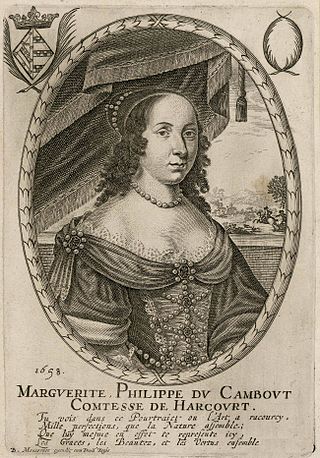Duke of Coislin (Fr.: duc de Coislin) was a title of nobility in the peerage of France created by Louis XIV of France in 1665 for Armand de Camboust.
Duke of Coislin (Fr.: duc de Coislin) was a title of nobility in the peerage of France created by Louis XIV of France in 1665 for Armand de Camboust.
| From | To | Duke of Coislin | Relationship to predecessor |
|---|---|---|---|
| 1665 | 1702 | Armand de Camboust, duc de Coislin (1635-1702) | First Duke of Coislin |
| 1702 | 1710 | Pierre de Camboust, duc de Coislin (1655-1710) | Son of Armand de Camboust, duc de Coislin |
| 1710 | 1732 | Henri Charles du Cambout de Coislin (1665-1732) | Brother of Pierre de Camboust, duc de Coislin |

Pierre Séguier was a French statesman, chancellor of France from 1635.
Tractatus coislinianus is an ancient Greek manuscript outlining a theory of comedy in the tradition of Aristotle's Poetics.

The Automobile Club of France (ACF) is a men's club founded on 12 November 1895 by Albert de Dion, Paul Meyan, and its first president, the Dutch-born Baron Étienne van Zuylen van Nyevelt.
Uncial 056 (in the Gregory-Aland numbering), O7 (von Soden), is a Greek uncial manuscript of the New Testament, dated paleographically to the 10th century.

Fonds Coislin is a collection of Greek manuscripts acquired by Pierre Séguier, but named after Henri-Charles de Coislin, its second owner. It is now held in the National Library of France, as one of three fonds of Greek manuscripts: fonds grec, fonds Coislin, and supplément grec.

Henri Charles du Cambout, 3rd Duke of Coislin was a French prelate. He was bishop of Metz from 1697 to 1732, and duc de Coislin from 1710.
Pierre du Cambout, 2nd Duke of Coislin (1664–1710) was a duke and peer of France, succeeding his father. He was admitted to the Académie française in his father's seat on 11 December 1702 by the Abbé de Dangeau.

Pierre du Cambout was a French prelate. He was a grandson of Pierre Séguier and held many important benefices - abbot of Jumièges, in 1641, of Saint-Victor, in 1643, canon of Paris, and first king's almoner in 1663. He was finally Grand Almoner of France and bishop of Orléans from 1665 to 1706, as well as being made cardinal priest of Trinità dei Monti.
Minuscule 34 (in the Gregory-Aland numbering), A19 (Von Soden). It is a Greek minuscule manuscript of the New Testament, written on vellum. Palaeographically it has been assigned to the 10th century.
Minuscule 329 (in the Gregory-Aland numbering), A219 (Soden), is a Greek minuscule manuscript of the New Testament, on parchment. Palaeographically it has been assigned to the 12th century.
Minuscule 331, ε 1085 (Soden), is a Greek minuscule manuscript of the New Testament, on parchment. Palaeographically it has been assigned to the 11th century. According to Gregory the 10th century is also possible. It has marginalia.

Jean Louis Tocqué was a French painter. He specialized in portrait painting.
Events from the year 1702 in France

Marguerite-Philippe du Cambout was a French noblewoman.
Marie Anne de Coislin (1732-1817), was a French aristocrat, known as the mistress to Louis XV of France in 1755. She was the king's Petite maîtresse, not his Maîtresse-en-titre.
François Cureau de La Chambre was a French physician during the reign of Louis XIV.